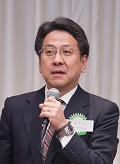Strategic Approaches to Promote Infrastructure Exports and Challenges Japan Faces
29 November, 2017
Mr. Tadashi Maeda
CEO, Executive Managing Director,
Japan Bank for International Cooperation
�� I have been in charge of formulating strategies to promote infrastructure exports for several regimes, starting as Special Advisor to the DPJ (Democratic Party of Japan) cabinet. The current Abe administration has reinforced the strategies as we move into a new and unsettling geopolitical phase. The rise of China as well as the ��America First�� policy of the Trump administration could create a power vacuum in Northeast Asia. I believe infrastructure exports will serve as a linchpin to fortify connectivity towards stabilizing this region in the future. Today let me focus on our dialogue with the U.S.A. as it is of crucial importance to ensure their continued commitment to Asia.
I have been in charge of formulating strategies to promote infrastructure exports for several regimes, starting as Special Advisor to the DPJ (Democratic Party of Japan) cabinet. The current Abe administration has reinforced the strategies as we move into a new and unsettling geopolitical phase. The rise of China as well as the ��America First�� policy of the Trump administration could create a power vacuum in Northeast Asia. I believe infrastructure exports will serve as a linchpin to fortify connectivity towards stabilizing this region in the future. Today let me focus on our dialogue with the U.S.A. as it is of crucial importance to ensure their continued commitment to Asia.
��The U.S.-Japan Economic Dialogue was launched this April with the bilateral meeting between Japanese Finance Minister Taro Aso and U.S. Vice President Mike Pence. The two agreed to promote dialogue on three central issues of ��Common Strategy on Trade and Investment Rules/Issues,�� ��Cooperation in Economic and Structural Policies�� and ��Sectoral Cooperation�� in fields such as infrastructure investment and energy. In June, the Japanese Trade Minister Hiroshige Seko met the U.S. Energy Secretary Rick Perry to discuss bilateral cooperation on LNG (liquefied natural gas) to promote ��sectoral cooperation�� in the energy sector, which will enhance economic collaboration based on a new transparent scheme. In October, the Japanese Ministry of Economy, Trade and Industry hosted the LNG Producer-Consumer Conference where Japan pledged to provide 10 billion US dollars to joint public-private projects which will ��supply LNG or build LNG infrastructure in Asia��. These successful negotiations led to the agreement in November 2017 by President Trump and Prime Minister Abe during the Summit Meeting in Tokyo to develop ��Japan-U.S. Strategic Energy Partnership�� within the framework of U.S.-Japan Economic Dialogue.
��Japan has become the world��s largest LNG importer, accounting for 40% of the total worth 90 million tons, as it has made dramatic moves into the LNG market since the Great East Japan Earthquake and the Fukushima nuclear power plant accidents that suspended operations of all the nuclear power plants. While the LNG market is forecasted to remain oversupplied for a while, strong growth in its import among emerging Asian economies will mean demand exceeds supply on a global scale as early as 2023. It requires a few years to lay the foundation and activate the energy-related infrastructure, such as terminals, storage facilities, pipelines and gas distribution networks. Not a few countries, including Japan, are working towards setting up an LNG trading hub and to invest in multiple elements of the gas value chain to be well-positioned to meet future consumption growth in Asia.
��Neighboring countries of Japan, South Korea and China, are investing extensively to secure a stable supply of LNG. The South Korean Government plans to increase LNG supplies from the Yamal LNG project in Russia, to be shipped eastwards along the Northern Sea Route. China propels its ��One Belt, One Route�� initiative to develop the land-based Silk Road Economic Belt and the sea-based Maritime Silk Road, focusing on connectivity and cooperation among Eurasian countries. The country has invested vast capital into various sources, including the BCIM (Bangladesh, China, India and Myanmar) Economic Corridor as well as the China-Pakistan Economic Corridor, to facilitate trade, link the economies of various countries and build up an extensive energy infrastructure. China has also led the creation of the Asian Infrastructure Investment Bank (AIIB) in 2016 which has an initial capital of 100 billion US dollars. To date, AIIB has approved loans for a modest number of 31 projects worth 3.5 billion US dollars, of which most are co-financed with other multilateral lenders such as the World Bank and the Asian Development Bank.
��The Japanese Government basically supports the ��One Belt, One Route�� initiative provided that 1) its infrastructure is fully accessible to all users, 2) it ensures transparent and fair procurement, 3) its projects are economically viable, and 4) loans are repayable and will not undermine financial soundness of the debtor economies. While China��s overseas infrastructure projects keep expanding rapidly, Japan has received a moderate number of orders. The Japan Bank for International Cooperation (JBIC), therefore, are now working in collaboration with the China Development Bank and the Export-Import Bank of China for information-sharing to avert the risk of default as well as seek potential joint-projects in third countries. The Abe Administration has also taken different measures to improve relationships with Russia. JBIC has established a 1-billion-dollar Russia-Japan Investment Fund jointly with the Russian Direct Investment Fund to reinforce economic cooperation between the two countries. JBIC has also signed a Memorandum of Understanding with the Overseas Private Investment Cooperation, a self-sustaining U.S. Government Agency, to formulate a framework to ensure further engagement of Japan and the U.S.A with Asian countries which have an enormous geopolitical significance. Let me highlight that today, OPIC President and CEO Mr. Washburne is having a tripartite meeting with U.S. President Advisor Ms. Ivanka Trump and Prime Minister of India Mr. Modi in Hyderabad, India. I strongly believe that such reinforcement of relationships among Japan, U.S.A. and India will have a positive impact on the geopolitical stability in the region and be beneficial to promote infrastructure exports from Japan.